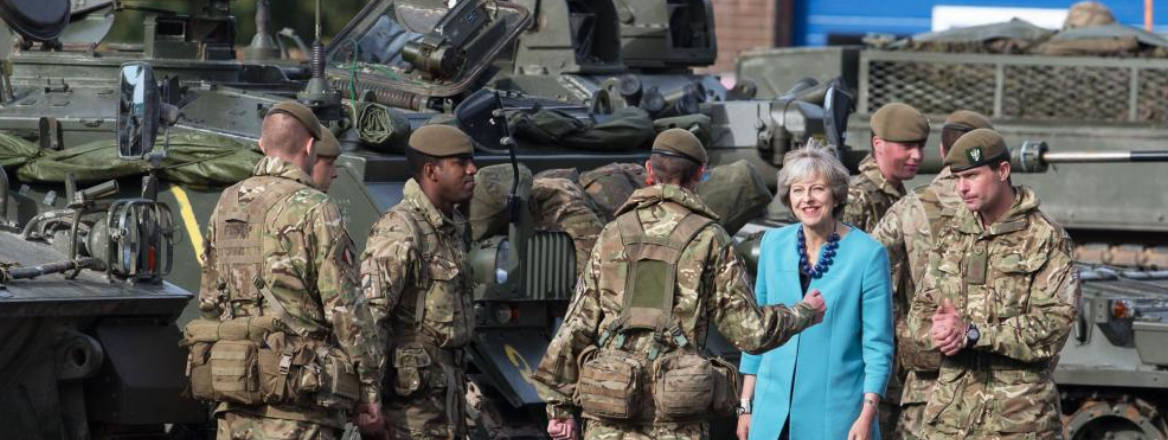General Election 2017: Bad Times for Hard Facts on Defence Spending
In most elections, defence is more a matter of image and mythology than real policy substance. So, too, this time, in what is destined to be known as the ‘Brexit election’.
The 2015 election campaign, interestingly, had discernible effects on defence policy when the Conservatives, fearing defeat, made a series of commitments that effectively built into the defence budget some significant spending increases for the future.
However, this time, the 8 June election looks set to revert to type, even if a major foreign crisis erupts in the middle of the campaign to thrust defence into the spotlight.
Electoral mythology is that defence suffers under Labour governments, both in spending and in strategic coherence, and prospers under the Conservatives.
In historical fact, the opposite tends to be true; compare the strategic and spending consistency of the Labour eras of Ernest Bevin, Douglas Alexander, Denis Healey, George Robertson and John Reid against the explicitly cost-cutting defence reviews of Conservative ministers such as Duncan Sandys, John Nott or Tom King.
Conservative governments often cut into defence spending because they can; Labour governments are reluctant to cut it because they dare not. The independent nuclear deterrent is the ultimate general election defence symbol.
Labour’s debacle in the 1983 election has taken on the mantle of Valhalla itself in the mythology of all the parties; nuclear unilateralism is synonymous – at least during an election – with a policy of weak-minded surrender.
Conventional electoral wisdom is therefore that Conservatives can gain votes on defence, but that Labour and Liberal Democrats can only lose them. Like every major policy area, ‘defence and security’ will get its day in the campaign, but all the indications are that it will be merely imagery and mythology.
The Labour Party is expected to commit to an immediate defence review if it wins the election – the regular commitment of all parties when they do not have a consistent policy or just want to avoid discussing defence.
The Conservative Party stands on its record and will insist that it corrected the previous drift in defence policy during the 2015 Strategic Defence and Security Review (SDSR) and will carry that through to the next scheduled review in 2020.
The Tory argument is already well-articulated: the government is spending 2% of GDP on defence and urging other NATO allies to do the same; it is spending an extra £500 million per annum up to 2021, when defence spending will have risen from £35.1 billion in 2015–16 to £39.7 billion in 2020–21. And the Conservatives will respond incisively to the new security challenges the UK faces.
But if these headline facts bolster the Conservative image, they cannot disguise some underlying weaknesses. Serious defence analysts accept that the 2015 SDSR was strategically coherent and, if the country is essentially unwilling to devote more national resources to defence, at least it set defence on a plausible and sustainable course for the 2020s.
However, even after two years it is drifting off course. Although the Tories will not admit that they should conduct another immediate review if re-elected, it has become axiomatic that the new government will have to conduct a quiet review very quickly as defence increasingly falls back into all the old habits of drift and evasion that leave the Armed Forces much hollower than they appear.
In essence, defence planners will have to look again at their requirements, commitments and costs to make the promises of the 2015 review stick.
The government’s own financial summary of the Defence Equipment Plan, the independent National Audit Office’s analysis and then the Public Accounts Committee (PAC) on 25 April all tell different parts of the same financial story.
The government now plans to spend £178 billion on new equipment and support over the next ten years, covering all the new world-class military systems the forces decided in 2015 they needed to remain a potent, first world military power in the future.
But since then, the MoD has entered into £24.4 billion of new commitments to make good on this promise and most of this is based on funding that is ‘vulnerable’ in some way.
Only £6.4 billion of the £24.4 billion total is genuinely new cash. Some £7.3 billion of it is from the ‘headroom’ built into the existing plan – quite allowable, but as a contingency amount it can be allocated only once.
Another £3.4 billion of ‘headroom’ has similarly been put into equipment from the central MoD budget and £7.3 billion of new, as yet unidentified ‘efficiency savings’, both from equipment and from the core budget is included.
Added to this are the downstream costs of sterling’s devaluation following Brexit; around 21% against the dollar in light of almost $29 billion of the equipment plan to be purchased in dollars. On present trends, that is likely to be £6 billion or so more than might be anticipated before Brexit.
Of course, it might all come good, but it would now take very little to knock the equipment plan further off-course. As the PAC put it, the equipment plan is ‘at greater risk of becoming unaffordable than at any time since its inception in 2012’.
Equipment and support accounts for over 40% of the total defence budget and other parts of the system are now under well-documented strain as they still try to find all the efficiency savings demanded in 2015.
If new equipment is agreed for good enough strategic reasons, the numbers to be procured are in many cases still at issue. How many F-35 Lightning II aircraft will the UK actually buy (£5 billion to date and counting)? Will there be a full replacement of 50 new Apache AH-64D helicopters (£1.8 billion)? Will the nine P-8 Maritime Patrol Aircraft (£3 billion) be procured over a much longer period? How many Ajax armoured vehicle variants (£3.5 billion to date and counting) will the Army eventually get as it tries to restructure itself by 2025?
In truth, the general election could reasonably question whether the UK’s strategic ambitions – particularly post-Brexit – exceed its commitment and ability to achieve them; indeed, whether such ambitions are still appropriate. But the reality will turn on momentary images of whose hands seem safest at the defence helm as the country sails towards its Brexit destiny.
WRITTEN BY
Professor Michael Clarke
RUSI Distinguished Fellow, Military Sciences


